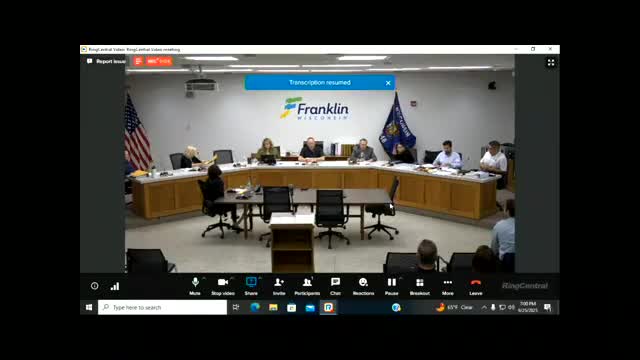Franklin Common Council Holds Special Meeting to Address School District Legal Issues
September 26, 2025 | Franklin City, Milwaukee County, Wisconsin
This article was created by AI summarizing key points discussed. AI makes mistakes, so for full details and context, please refer to the video of the full meeting. Please report any errors so we can fix them. Report an error »

Franklin's Common Council convened on September 25, 2025, to address pressing legal issues surrounding a contentious school project, with significant community input shaping the discussions. The meeting, marked by a citizen comment period, highlighted the division within the community regarding the proposed changes to Highview Drive, which is currently designated for emergency access only.
Mayor Nelson opened the meeting by acknowledging the community's divided stance on the matter, emphasizing the council's commitment to due process. Citizens voiced their concerns about the potential reopening of Highview Drive to regular traffic, citing safety risks and increased congestion in residential neighborhoods. Judith Williams Klacke, a local resident, raised questions about the council's reconsideration of a previously passed resolution, urging the council to uphold its earlier decision against granting a conditional use permit for the school project.
Other residents echoed these sentiments, expressing frustration over the council's decision to hold an emergency meeting with less than 24 hours' notice. They argued that such actions undermine public trust and transparency. Nicole Schlacks, another concerned citizen, urged the council to resist pressures from the school district, which has threatened legal action over the council's decisions. She emphasized the need for the council to prioritize community safety and uphold previous votes that restrict access on Highview Drive.
The council's discussions also touched on the implications of potential litigation from the school, with members acknowledging the challenges of navigating legal complexities while addressing community concerns. As the meeting progressed, the council planned to enter a closed session to further deliberate on the legal aspects of the situation.
The outcome of this meeting is poised to have lasting effects on the community, as residents await the council's decision on whether to maintain the current restrictions on Highview Drive. The council's commitment to balancing legal obligations with community safety will be crucial in determining the next steps in this ongoing debate.
Mayor Nelson opened the meeting by acknowledging the community's divided stance on the matter, emphasizing the council's commitment to due process. Citizens voiced their concerns about the potential reopening of Highview Drive to regular traffic, citing safety risks and increased congestion in residential neighborhoods. Judith Williams Klacke, a local resident, raised questions about the council's reconsideration of a previously passed resolution, urging the council to uphold its earlier decision against granting a conditional use permit for the school project.
Other residents echoed these sentiments, expressing frustration over the council's decision to hold an emergency meeting with less than 24 hours' notice. They argued that such actions undermine public trust and transparency. Nicole Schlacks, another concerned citizen, urged the council to resist pressures from the school district, which has threatened legal action over the council's decisions. She emphasized the need for the council to prioritize community safety and uphold previous votes that restrict access on Highview Drive.
The council's discussions also touched on the implications of potential litigation from the school, with members acknowledging the challenges of navigating legal complexities while addressing community concerns. As the meeting progressed, the council planned to enter a closed session to further deliberate on the legal aspects of the situation.
The outcome of this meeting is poised to have lasting effects on the community, as residents await the council's decision on whether to maintain the current restrictions on Highview Drive. The council's commitment to balancing legal obligations with community safety will be crucial in determining the next steps in this ongoing debate.
View full meeting
This article is based on a recent meeting—watch the full video and explore the complete transcript for deeper insights into the discussion.
View full meeting
